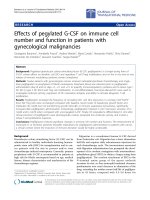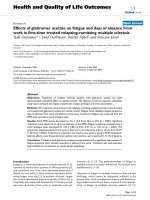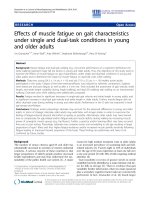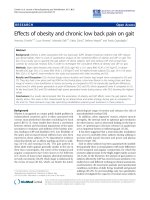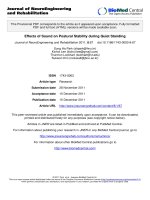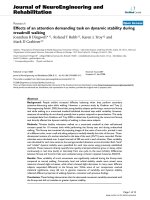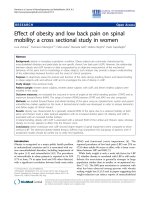báo cáo hóa học:" Effects of obesity on bone metabolism" potx
Bạn đang xem bản rút gọn của tài liệu. Xem và tải ngay bản đầy đủ của tài liệu tại đây (585.15 KB, 7 trang )
REVIEW Open Access
Effects of obesity on bone metabolism
Jay J Cao
Abstract
Obesity is traditionally viewed to be beneficial to bone health because of well-established positive effect of
mechanical loading conferred by body weight on bone formation, despite being a risk factor for many other
chronic health disorders. Although body mass has a positive effect on bone formation, whether the mass derived
from an obesity condition or excessive fat accumulation is beneficial to bone remains controversial. The underline
pathophysiological relationship between obesity and bone is complex and continues to be an active research area.
Recent data from epidemiological and animal studies strongly support that fat accumulation is detrimental to bone
mass. To our knowledge, obesity possibly affects bone metabolism through several mechanisms. Because both
adipocytes and osteoblasts are derived from a common multipotential mesenchymal stem cell, obesity may
increase adipocyte differentiation and fat accumulation while decrease osteoblast differentiation and bone
formation. Obesity is associated with chronic inflammation. The increased circulating and tissue proinflammatory
cytokines in obesity may promote osteoclast activity and bone resorption through modifying the receptor activator
of NF-B (RANK)/RANK ligand/osteoprotegerin pathway. Furthermore, the excessive secretion of leptin and/or
decreased production of adiponectin by adipocytes in obesity may either directly affect bone formation or
indirectly affect bone resorption through up-regulated proinflammatory cytokine production. Finally, high-fat intake
may interfere with intestinal calcium absorption and therefore decrease calcium availability for bone formation.
Unraveling the relationship between fat and bone metabolism at molecular level may help us to develop
therapeutic agents to prevent or treat both obesity and osteoporosis.
Obesity, defined as having a body mass index ≥ 30 kg/m
2
, is a condition in which excessive body fat accumulates
to a degree that adversely affects health [1]. The rates of obesity rates have doubled since 1980 [2] and as of 2007,
33% of men and 35% of women in the US are obese [3]. Obesity is positively associated to many chronic disorders
such as hypertension, dyslipidemia, type 2 diabe tes mellitus, coronary heart disease, and certain cancers [4-6]. It is
estimated that the direct medical cost associate d with obesity in the United States is ~$100 billio n per year [7].
Bone mass and strength decrease during adulthood, especially in women after menopause [8]. These changes can
culminate in osteoporosis, a disease characterized by low bone mass and microarchitectural deterioration resulting
in increased bone fracture risk. It is estimated that there are about 10 million Americans over the age of 50 who
have osteoporosis while another 34 million people are at risk of developing the disease [9]. In 2001, osteoporosis
alone accounted for some $17 billion in direct annual healthcare expenditure.
Several lines of evidence suggest that obesity and bone metabolism are interrelated. First, both osteoblasts (bone
forming cells) and adipocytes (energy storing cells) are derived from a common mesenchymal stem cell [10] and
agents inhibiting adipogenesis stimulated osteoblast differentiation [11-13] and vice versa, those inhibiting
osteoblastogenesis increased adipogenesis [14]. Second, decreased bone marrow osteoblastogenesis with aging is
usually accompanied with increased marrow adipogenesis [15,16]. Third, chronic use of steroid hormone, such as
glucocorticoid, results in obesity accompanied by rapid bone loss [17,18]. Fourth, both obesity and osteoporosis are
associated with elevated oxidative stress and increased production of proinflammatory cytokines [19,20]. At present, the
mechanisms for the effects of obesity on bone metabolism are not well defined and will be the focus of this review.
Keywords: bone, fat, obesity, osteopor osis, inflammation
Correspondence:
USDA ARS Grand Forks Human Nutrition Research Center 2420 2
nd
Ave N
Grand Forks, ND 58202-9034, USA
Cao Journal of Orthopaedic Surgery and Research 2011, 6:30
/>© 2011 Cao; licensee BioMed Central Ltd. This is an Open Access article distributed under the terms of the Creative Commons
Attribution License ( which permits unr estricted use, distribution, and reproduction in
any medium, provided the original work is properly cited.
Proinflammatory cytokines are elevated in
obesity
Obesity is associated with low-grade chro nic inflamma-
tion. The seminal finding that the expression of a proin-
flammatory cytokine, tumor necrosis factor-a (TNF-a),
is elevated in the adipose tissue of obese mice p rovided
the first evidence of a link between obesity and inflam-
mation [21]. Later, the discovery of leptin, a small poly-
peptide hormone secreted primarily by the adipocytes,
further supports that adipose is not just a energy storing
organ and it is also an active endocrine tissue [22,23].
Since then, numerous experimental, epidemiological,
and clinical studies have established that obesity is asso-
ciated with a chronic inflammatory response, abnormal
cytokine production, increased acute-phase reactants,
and activation of inflammatory signaling pathways, and
that these processes are involved in and responsible for
the development of obesity-related diseases [24]. In obe-
sity, adipose tissue is infiltrated with an increased
amount of macrop hages, which are an important source
of inflammatory cytokines [25,26]. Obese humans
express higher levels of TNF-a in adipose tissue than do
lean individuals [27]. Adipose tissue also produces other
proinflammatory factors including interlukin-6 (IL-6)
and C-reactive protein (CRP) [28,29]. Obesity has also
been implicated in the development or progression of
musculoskeletal diseases such as osteoarthritis, a com-
mon inflammatory bone disease [30]. Numerous studies
have confirmed that increased production of proinflam-
matory cytokines are critical in the development and
progression of obesity-related health disorders [31].
Obese individuals show abnormal circulating levels of
TNF-a, IL-6, CRP, adiponectin and leptin. Adiponectin
and leptin, which also mediate chronic inflammation,
are adipokines produced by adipose tissue. Leptin has
pleiotropic effects that modulate energy expenditure,
appetite, and neuroen docrine functions. Leptin, which is
increased in obesity, has been found to stimulate inflam-
matory responses in humans [32,33]. In contrast adipo-
nectin acts as an anti-inflammatory cytokine which
suppress es TNF-a-induced NF-B activation [34]. It has
been found that plasma adiponectin concentrations are
lower in obese subjects as compared to non-obese indi-
viduals [35].
In a cross-sectional study of 16,573 in dividuals in th e
third National Health and Nutrition Examination Survey
(NHANES) (1984-1994), logistic regression an alysis
showed that odds ratios for an e levated serum CRP
among indiv iduals with a body mass index (BMI) of 25-
< 30, 30- < 35, 35- < 40, and ≥40 were 1.51, 3.9, 6.11,
and 9.30, respectively [36]. In another cross-sectional
study, CRP, IL-6 and leptin were significantly positively
related to degree of adiposity [37].
Proinflammatory cytokines increase bone
resorption
Bone is a dynamic organ that continuously undergoes
significant turnover, a process called modeling/remodel-
ing involving bone resorption by osteoclasts and bone
formation by osteoblasts [38]. Therefore, bone mass at
any particular time reflects the balance between bone for-
mation and resorption. At the cellular level, osteoblast
number and activity decrease while osteoclast number
and activity increase with aging [39,40]. It is now estab-
lished that osteoblasts regulate the recruitment and activ-
ity of osteoclasts through the expression of the receptor
activator of NF-B ligand (RANKL) and osteoprotegerin
(OPG) (Figure 1). RANKL is expressed on the osteoblast/
stromal cell surface and binds to its receptor, RANK, on
the surface of hematopoietic precursor cells to stimulate
osteoclast differentiation and maturation in the presence
of macrophage colony stimulati on factor (M-CSF). OPG,
a decoy receptor secreted by osteoblasts, binds RANKL
to prevent the activation of RANK and, therefore, to pre-
vent osteoclast differentiation and activation [41,42]. It
has been demonstrated that increased osteoclastic activity
and increased bone resorption in postmenopausal
women is positively correlated with the upregulation of
RANKL [39,43,44].
Proinflammatory cytokines including TNF-a, IL-1, and
IL-6 are key mediators in the process of osteoclast dif-
ferentiation and bone resorption. Chronic inflammation
and increased proinflammatory cytokines induce bone
resorption and bone loss in patients with periodontitis
[45], pancreatitis [46], inflammatory bowel disease [47],
and rheumatoid arthritis [48]. It has also been estab-
lished that upregulated proinflammatory cytokines are
primary mediators of o steopenia or osteoporosis. The
accelerated bone loss at menopause is linked to
increased production of proinflammatory cytokines
including TNF-a, IL-1, and IL-6 [20]. These proinflam-
matory cytokines are capable of stimulating osteoclast
activity through the regulation of the RANKL/RANK/
OPG pathway [49,50]. In mice lacking IL-1b and TNF
genes [51] or over-expressing soluble TNF-a decoy
receptor [52], ovariectomy did not cause bone loss.
BlockingtheactionofIL-1withanIL-1receptor
antagonist, or the signaling of TNF-a with a TNF-bi nd-
ing protein, decreased osteoclast formation and bone
resorption in ovariectomized mice [53]. The significant
increase in the development of osteoarthritis in obese
human subjects is another evidence that chronic inflam-
mation influences bone metabolism [30].
Obesity affects bone turnover
Obesity is t raditionally thought to be beneficial to bone
and, thus, to protect against osteoporosis [5,54 ,55].
Cao Journal of Orthopaedic Surgery and Research 2011, 6:30
/>Page 2 of 7
Mechanical loading stimulates bone formation by
decreasing apoptosis and increasing proliferation and
differentiation of osteoblasts and osteocytes [56] through
the Wnt/b-catenin signaling pathway [57,58]. Therefore,
mechanical loading con ferred by b ody weight is p art of
the assumption that has led to widespread belief that
obesity may prevent bone loss and osteoporosis [59-63].
However, recent reports have shown that excessive fat
mass may not protect humans from osteoporosis and in
fact, increased fat mass is associated with low total bone
mineral density and tota l bone mineral con tent [64-67].
In a cross-sectional study of 60 females between 10 and
19 years of age, the percent of body fat was linked to
suboptimal attainment of peak bone mass [68].
Increased adiposity may also be linked to the increased
risk of bone fracture. For example, in a c ase-control
study of 100 patients with fractures and 100 age-
matched fracture-free control subjects aged 3 to 19
years, high adiposity are associated with increased risk
of distal forearm fractures [69]. In another large cross-
sectional study of about 13,000 adult men, pre- and
post-menopausal women, percentage of body fat was
positive associated with osteopenia and nonspine frac-
tures [66].
In a leptin-deficient (ob/ob) mouse model for obesity,
mice weighed twice as much as lean mice but had lower
femoral bone mineral density, cortical thickness, and
trabecular bone volume [70]. Obviously the positive
effect of mechanical loading of increased body weight
could not overcome the detrimental effect of leptin-defi-
ciency (or possibly obesity) on bone in these mice. The
apparent competing effects of adiposity and mechanical
loading on bone metabolism remain an active research
area. Research findings suggest that factors other than
body weight are involved in the final outcome of obesity
on bone health.
While research with obese animal model has estab-
lished the negative effects of adiposity on bone metabo-
lism, studies with human subjects continue to be
controversial. Human obesity is a complex issue which
in general involves excessive consumption of other
nutrients, such as protein and minerals, known to influ-
ence bone metabolism [71]. Findings of the effects of
obesity on bone health in humans have been based on
Figure 1 Bone metabolism regulated by adipocytes, osteoblasts, and osteoclasts. Fat accumulation is closely related to bone formation
and resorption. Osteoblasts and adipocytes are derived from a common multipotential mesenchymal stem cell. Osteoclasts are differentiated
from monocyte/macrophage precursors of hematopoietic stem cells origin. Adipocytes secrete several cytokines such as TNF-a, IL-1b, IL-6,
adiponectin, and leptin which are capable of modulating osteoclastogenesis through RANKL/RANK/OPG pathway. IL, interleukin; OPG,
osteoprotegerin; RANK, receptor activator of nuclear transcription factor B; RANKL, receptor activator of nuclear transcription factor B ligand;
TNF-a, tumor necrosis factor alpha;
Cao Journal of Orthopaedic Surgery and Research 2011, 6:30
/>Page 3 of 7
statistical correlation or modeling rather than controlled
trials. Thus, controlled studies with the obese animal
model are useful for dissecting the mechanisms upon
which excessive fat accumulation affect on bone
metabolism.
Using a diet-induced obese mouse model, we demon-
strated that feeding mice a high-fat diet (45% energy as
fat) for 14 wks decreases trabecular bone volume and
trabecular number in the proximal tibia despite a sub-
stantial increase in body weight and bone formation
markers in cultured BMSC [72]. These structural
changes are accompanied by increases in serum leptin
and TRAP levels, the ratio of RANKL/OPG expression
in cultured osteoblasts, and the number of TRAP-posi-
tive osteoclasts [72,73]. Increased osteoclast activity and
decreased expression of IL-10, an anti-inflammatory
cytokine, by bone marrow-derived macrophages in diet-
induced obese mice have also been reported by others
[74]. High fat-induced obese animals exhibited increased
bone marrow adiposity accompanied by reduced BMD
in different skeletal sites, up-regulation of peroxisome
proliferator-activated receptor g, cathepsin k, IL-6 and
TNF-a [75].
Based on a vailable literature, o besity appears t o affect
bone metabolism through several mechanisms. Obesity
may decrease bone format ion (osteoblastogenesis) while
increasing adipogenesis because adipocyte and osteo-
blasts are derived from a common multi-potential
mesenchymal stem cell (Figure 1) [76]. For example,
mechanical loading promotes osteoblast differentiation
and inhibits adipogenesis by down-regulating peroxi-
some proliferator-activated receptor gamma (PPARg)or
by stimulating a durable beta-catemin signal [12,13].
Activation of PPARg by thiazolidinediones decreased
osteoblast differentiation, bone mineral density and tra-
becular bone mass while increasing adipocytes differen-
tiation and bone marrow adipose tissue volume
[11,77,78].
Obesity may increase bone resorption through upregu-
lating proinflammatory cytokines such as IL-6 and TNF-
a. These proinflammatory cytokines are capable of sti-
mulating osteoclast activitythroughtheregulationof
the RANKL/RANK/OPG pathway [49,50]. Obesity is sig-
nificantly associated with degenerative and inflammatory
musculoskeletal system [79]. Bone marrow adipocytes
also may directly regulate the osteoclast progenitors,
hematopoietic cells [80]. For example, when expressed
with a dominant-negative form of CCAAT-enhancer-
binding proteins (C/EBP) under the adipocyte fatty-acid-
binding protein 4 promoter, mice cannot form adipo-
cytes[81].Thesemicelackwhiteadiposetissueand
have increased bone mineral density [82].
Obesity may affe ct bone metabolism directly or indir-
ectly through adipocyte-derived cytokines such as leptin
and adiponectin. Obesity is associated with significant
increase in serum leptin [32,33] and decrease in adipo-
nectin [35]. The action of leptin on bone appears to be
complex and both positive [83,84] and negative [85,86]
effects have been reported. It appears that its action
may depend on curre nt leptin status and the mode of
the action (central or peripheral effects). Overproduction
of leptin, as seen in obese animal models, may have
negative effects on bone metaboli sm [73]. Increased
serum leptin leve l has been found a negativ e regulator
of bone mass in a mouse model [85]. Adiponectin is
another cytokine secreted by adipocytes and has anti-
inflammatory effect [34]. In animal model, adiponectin
has been reported to inhibit osteoclastogenesis, reduce
bone resorption, and increase b one mass [87]. Obese
subjects have low serum adiponectin concentrations as
compared to those normal subjects [35]. Increased
secretion of leptin (and/or decreased production of adi-
ponectin) by adipocytes may also contribute to macro-
phage accumulation by simulating transport of
macrophages to adipose tissue [88] and promoting adhe-
sion of macrophages to endothelial cells, respectively
[89].
Finally, a high-fat diet, often a cause of obesity, has
been reported to interfere with intestinal calcium
absorption. Free fatty acids can form unabsorbable inso-
luble calcium soaps and therefore contributing to low
calcium absorption [90-92].
Increased body weight associated with obesity may
counteract the detrimental effects of obesity on bone
metabolism. It is well established that body weight or
body mass index (BMI) is positively correlated with
bone mineral density or bone mass [59,93] and low
body weight or BMI is a risk factor for low bone mass
and increased bone loss in humans [60]. Howe ver, stu-
dies indicate the positive effec ts of body we ight could
not completely offset the detrimental effects of obesity
on bone, at least in obese animal models.
Conclusions
Accumula ting data suggest that obesity is detrimental to
bone health despite potential positive effects of mechan-
ical loading conferred by increased body weight with
obesity on bones. The decreased bone mass with obesity
may be due to increased marrow adipogenesis at the
expense of osteoblastogenesis, and/or increased osteo-
clastogenesis because of up-regulated production of
proinflammatory cytokines, and/or excessive leptin
secretion , or reduced adiponect in production, and/o r
reduced calcium absorption associated with high fat
intake. Understanding the relationship b etween obesity
and bone metabolism may help identify new molecular
targets that can increase osteoblastogenesis while inhi-
biting adipogenesis and/or decreasing osteoclastogenesis.
Cao Journal of Orthopaedic Surgery and Research 2011, 6:30
/>Page 4 of 7
Ultimately, this knowledge may lead us to develop new
therapeutic interventions to prevent both obesity and
osteoporosis.
Conflict of interests
The authors declare that they h ave no competing
interests.
Author’s information
Dr. Cao received a Doctoral degree in nutrition from the
University of Fl orida, Gainesville, Florida, USA. He
worked as a postdoctoral research fellow in mineral
nutrition at the Food Science and Human Nutrition
Department, University of Florida and in bone biology
at the Department of Medi cine, University of California
at San Francisco. Dr. Cao has published more than 30
papers in nutrition and bone biology fields. He has pre-
sented his researc h at many national and international
conferences. Currently, he is a Research Nutritionist at
the USDA ARS Grand Forks Human Nutrition Research
Center where he conducts research focusing on the
nutritional and physical activity regulation of bone
metabolism using obese animal models. Dr. Cao also
investigates the effects of dietary protein and acid-base
balance on c alcium absorption, retention, and markers
of bone metabolism in human subjects.
List of abbreviations
CRP: C-reactive protein; IL: interleukin; OPG: osteoprotegerin; RANK: receptor
activator of nuclear transcription factor κB; RANKL: receptor activator of
nuclear transcription factor κB ligand; TNF-α: tumor necrosis factor alpha;
TRAP: tartrate-resistant acid phosphatase; BMI: body mass index;
Received: 30 April 2010 Accepted: 15 June 2011
Published: 15 June 2011
References
1. World Health Organization: Obesity: Preventing and managing the global
epidemic, no. 894. Geneva: WHO; 2000.
2. Ogden CL, Carroll MD, Curtin LR, McDowell MA, Tabak CJ, Flegal KM:
Prevalence of overweight and obesity in the United States, 1999-2004.
JAMA 2006, 295(13):1549-1555.
3. Bessesen DH: Update on obesity. J Clin Endocrinol Metab 2008,
93(6):2027-2034.
4. Messerli FH, Christie B, DeCarvalho JG, Aristimuno GG, Suarez DH,
Dreslinski GR, Frohlich ED: Obesity and essential hypertension.
Hemodynamics, intravascular volume, sodium excretion, and plasma
renin activity. Arch Intern Med 1981, 141(1):81-85.
5. Kopelman PG: Obesity as a medical problem. Nature 2000,
404(6778):635-643.
6. Mokdad AH, Bowman BA, Ford ES, Vinicor F, Marks JS, Koplan JP: The
continuing epidemics of obesity and diabetes in the United States. JAMA
2001, 286(10):1195-1200.
7. Wolf AM, Colditz GA: Current estimates of the economic cost of obesity
in the United States. Obes Res 1998, 6(2):97-106.
8. Riggs BL, Khosla S, Melton LJ 3: Sex steroids and the construction and
conservation of the adult skeleton. Endocrine reviews 2002, 23(3):279-302.
9. Melton LJ: The prevalence of osteoporosis: gender and racial
comparison. Calcif Tissue Int 2001, 69(4):179-181.
10. Gregoire FM, Smas CM, Sul HS: Understanding adipocyte differentiation.
Physiol Rev 1998, 78(3):783-809.
11. Gimble JM, Robinson CE, Wu X, Kelly KA, Rodriguez BR, Kliewer SA,
Lehmann JM, Morris DC: Peroxisome proliferator-activated receptor-
gamma activation by thiazolidinediones induces adipogenesis in bone
marrow stromal cells. Mol Pharmacol 1996, 50(5):1087-1094.
12. David V, Martin A, Lafage-Proust MH, Malaval L, Peyroche S, Jones DB,
Vico L, Guignandon A: Mechanical loading down-regulates peroxisome
proliferator-activated receptor gamma in bone marrow stromal cells and
favors osteoblastogenesis at the expense of adipogenesis. Endocrinology
2007, 148(5):2553-2562.
13. Sen B, Xie Z, Case N, Ma M, Rubin C, Rubin J: Mechanical strain inhibits
adipogenesis in mesenchymal stem cells by stimulating a durable beta-
catenin signal. Endocrinology 2008, 149(12):6065-6075.
14. Beresford JN, Bennett JH, Devlin C, Leboy PS, Owen ME: Evidence for an
inverse relationship between the differentiation of adipocytic and
osteogenic cells in rat marrow stromal cell cultures. J Cell Sci 1992,
102(Pt 2):341-351.
15. Moerman EJ, Teng K, Lipschitz DA, Lecka-Czernik B: Aging activates
adipogenic and suppresses osteogenic programs in mesenchymal
marrow stroma/stem cells: the role of PPAR-gamma2 transcription factor
and TGF-beta/BMP signaling pathways. Aging Cell 2004, 3(6)
:379-389.
16.
Meunier P, Aaron J, Edouard C, Vignon G: Osteoporosis and the
replacement of cell populations of the marrow by adipose tissue. A
quantitative study of 84 iliac bone biopsies. Clin Orthop Relat Res 1971,
80:147-154.
17. Mussig K, Remer T, Maser-Gluth C: Brief review: glucocorticoid excretion
in obesity. J Steroid Biochem Mol Biol 2010, 121(3-5):589-593.
18. Lane NE, Yao W: Glucocorticoid-induced bone fragility. Ann N Y Acad Sci
2010, 1192(1):81-83.
19. Wellen KE, Hotamisligil GS: Obesity-induced inflammatory changes in
adipose tissue. The Journal of clinical investigation 2003, 112(12):1785-1788.
20. Mundy GR: Osteoporosis and inflammation. Nutr Rev 2007, 65(12 Pt 2):
S147-151.
21. Hotamisligil GS, Shargill NS, Spiegelman BM: Adipose expression of tumor
necrosis factor-alpha: direct role in obesity-linked insulin resistance.
Science (New York, NY) 1993, 259(5091):87-91.
22. Zhang Y, Proenca R, Maffei M, Barone M, Leopold L, Friedman JM:
Positional cloning of the mouse obese gene and its human homologue.
Nature 1994, 372(6505):425-432.
23. Mohamed-Ali V, Pinkney JH, Coppack SW: Adipose tissue as an endocrine
and paracrine organ. Int J Obes Relat Metab Disord 1998, 22(12):1145-1158.
24. Hotamisligil GS: Inflammation and metabolic disorders. Nature 2006,
444(7121):860-867.
25. Xu H, Barnes GT, Yang Q, Tan G, Yang D, Chou CJ, Sole J, Nichols A,
Ross JS, Tartaglia LA, Chen H: Chronic inflammation in fat plays a crucial
role in the development of obesity-related insulin resistance. The Journal
of clinical investigation 2003, 112(12):1821-1830.
26. Weisberg SP, McCann D, Desai M, Rosenbaum M, Leibel RL, Ferrante AW Jr:
Obesity is associated with macrophage accumulation in adipose tissue.
The Journal of clinical investigation 2003, 112(12):1796-1808.
27. Hotamisligil GS, Arner P, Caro JF, Atkinson RL, Spiegelman BM: Increased
adipose tissue expression of tumor necrosis factor-alpha in human
obesity and insulin resistance. The Journal of clinical investigation 1995,
95(5):2409-2415.
28. Wellen KE, Hotamisligil GS: Inflammation, stress, and diabetes. The Journal
of clinical investigation 2005, 115(5):1111-1119.
29. Pradhan AD, Manson JE, Rifai N, Buring JE, Ridker PM: C-reactive protein,
interleukin 6, and risk of developing type 2 diabetes mellitus. Jama
2001, 286(3):327-334.
30. Anandacoomarasamy A, Caterson I, Sambrook P, Fransen M, March L: The
impact of obesity on the musculoskeletal system. International journal of
obesity (2005)
2008, 32(2):211-222.
31.
Shoelson SE, Herrero L, Naaz A: Obesity, inflammation, and insulin
resistance. Gastroenterology 2007, 132(6):2169-2180.
32. Canavan B, Salem RO, Schurgin S, Koutkia P, Lipinska I, Laposata M,
Grinspoon S: Effects of physiological leptin administration on markers of
inflammation, platelet activation, and platelet aggregation during caloric
deprivation. J Clin Endocrinol Metab 2005, 90(10):5779-5785.
33. van Dielen FM, van’t Veer C, Schols AM, Soeters PB, Buurman WA,
Greve JW: Increased leptin concentrations correlate with increased
concentrations of inflammatory markers in morbidly obese individuals.
Int J Obes Relat Metab Disord 2001, 25(12):1759-1766.
Cao Journal of Orthopaedic Surgery and Research 2011, 6:30
/>Page 5 of 7
34. Ouchi N, Kihara S, Arita Y, Okamoto Y, Maeda K, Kuriyama H, Hotta K,
Nishida M, Takahashi M, Muraguchi M, Ohmoto Y, Nakamura T, Yamashita S,
Funahashi T, Matsuzawa Y: Adiponectin, an adipocyte-derived plasma
protein, inhibits endothelial NF-kappaB signaling through a cAMP-
dependent pathway. Circulation 2000, 102(11):1296-1301.
35. Arita Y, Kihara S, Ouchi N, Takahashi M, Maeda K, Miyagawa J, Hotta K,
Shimomura I, Nakamura T, Miyaoka K, Kuriyama H, Nishida M, Yamashita S,
Okubo K, Matsubara K, Muraguchi M, Ohmoto Y, Funahashi T, Matsuzawa Y:
Paradoxical decrease of an adipose-specific protein, adiponectin, in
obesity. Biochem Biophys Res Commun 1999, 257(1):79-83.
36. Ford ES: Body mass index, diabetes, and C-reactive protein among U.S.
adults. Diabetes care 1999, 22(12):1971-1977.
37. Aeberli I, Molinari L, Spinas G, Lehmann R, l’Allemand D, Zimmermann MB:
Dietary intakes of fat and antioxidant vitamins are predictors of
subclinical inflammation in overweight Swiss children. The American
journal of clinical nutrition 2006, 84(4):748-755.
38. Novack DV, Teitelbaum SL: The osteoclast: friend or foe? Annual review of
pathology 2008, 3:457-484.
39. Cao JJ, Wronski TJ, Iwaniec U, Phleger L, Kurimoto P, Boudignon B,
Halloran BP: Aging increases stromal/osteoblastic cell-induced
osteoclastogenesis and alters the osteoclast precursor pool in the
mouse. J Bone Miner Res 2005, 20(9):1659-1668.
40. Perkins SL, Gibbons R, Kling S, Kahn AJ: Age-related bone loss in mice is
associated with an increased osteoclast progenitor pool. Bone 1994,
15(1):65-72.
41. Lacey DL, Timms E, Tan HL, Kelley MJ, Dunstan CR, Burgess T, Elliott R,
Colombero A, Elliott G, Scully S, Hsu H, Sullivan J, Hawkins N, Davy E,
Capparelli C, Eli A, Qian YX, Kaufman S, Sarosi I, Shalhoub V, Senaldi G,
Guo J, Delaney J, Boyle WJ: Osteoprotegerin ligand is a cytokine that
regulates osteoclast differentiation and activation. Cell 1998,
93(2):165-176.
42. Simonet WS, Lacey DL, Dunstan CR, Kelley M, Chang MS, Luthy R,
Nguyen HQ, Wooden S, Bennett L, Boone T, Shimamoto G, DeRose M,
Elliott R, Colombero A, Tan HL, Trail G, Sullivan J, Davy E, Bucay N,
Renshaw-Gegg L, Hughes TM, Hill D, Pattison W, Campbell P, Sander S,
Van G, Tarpley J, Derby P, Lee R, Boyle WJ: Osteoprotegerin: a novel
secreted protein involved in the regulation of bone density. Cell 1997,
89(2):309-319.
43. Eghbali-Fatourechi G, Khosla S, Sanyal A, Boyle WJ, Lacey DL, Riggs BL: Role
of RANK ligand in mediating increased bone resorption in early
postmenopausal women. J Clin Invest 2003, 111(8):1221-1230.
44. Cao J, Venton L, Sakata T, Halloran BP: Expression of RANKL and OPG
correlates with age-related bone loss in male C57BL/6 mice. J Bone Miner
Res 2003, 18(2):270-277.
45. Van Dyke TE, Serhan CN: R esolution of inflammation: a new paradigm
for the pathogenesis of periodontal diseases. JDentRes2003,
82(2):82-90.
46. Mann ST, Stracke H, Lange U, Klor HU, Teichmann J: Alterations of bone
mineral density and bone metabolism in patients with various grades of
chronic pancreatitis. Metabolism: clinical and experimental 2003,
52(5):579-585.
47. Bernstein CN, Leslie WD, Taback SP: Bone density in a population-based
cohort of premenopausal adult women with early onset inflammatory
bowel disease. Am J Gastroenterol
2003, 98(5):1094-1100.
48.
Romas E, Gillespie MT, Martin TJ: Involvement of receptor activator of
NFkappaB ligand and tumor necrosis factor-alpha in bone destruction in
rheumatoid arthritis. Bone 2002, 30(2):340-346.
49. Pfeilschifter J, Koditz R, Pfohl M, Schatz H: Changes in proinflammatory
cytokine activity after menopause. Endocrine reviews 2002, 23(1):90-119.
50. Khosla S: Minireview: the OPG/RANKL/RANK system. Endocrinology 2001,
142(12):5050-5055.
51. Vargas SJ, Naprta A, Glaccum M, Lee SK, Kalinowski J, Lorenzo JA:
Interleukin-6 expression and histomorphometry of bones from mice
deficient in receptors for interleukin-1 or tumor necrosis factor. J Bone
Miner Res 1996, 11(11):1736-1744.
52. Ammann P, Rizzoli R, Bonjour JP, Bourrin S, Meyer JM, Vassalli P, Garcia I:
Transgenic mice expressing soluble tumor necrosis factor-receptor are
protected against bone loss caused by estrogen deficiency. The Journal
of clinical investigation 1997, 99(7):1699-1703.
53. Kimble RB, Matayoshi AB, Vannice JL, Kung VT, Williams C, Pacifici R:
Simultaneous block of interleukin-1 and tumor necrosis factor is
required to completely prevent bone loss in the early postovariectomy
period. Endocrinology 1995, 136(7):3054-3061.
54. Reid IR, Ames R, Evans MC, Sharpe S, Gamble G, France JT, Lim TM,
Cundy TF: Determinants of total body and regional bone mineral density
in normal postmenopausal women–a key role for fat mass. The Journal
of clinical endocrinology and metabolism 1992, 75(1):45-51.
55. Villareal DT, Apovian CM, Kushner RF, Klein S: Obesity in older adults:
technical review and position statement of the American Society for
Nutrition and NAASO, The Obesity Society. The American journal of clinical
nutrition 2005, 82(5):923-934.
56. Ehrlich PJ, Lanyon LE: Mechanical strain and bone cell function: a review.
Osteoporos Int 2002, 13(9):688-700.
57. Bonewald LF, Johnson ML: Osteocytes, mechanosensing and Wnt
signaling. Bone 2008, 42(4):606-615.
58. Sawakami K, Robling AG, Ai M, Pitner ND, Liu D, Warden SJ, Li J, Maye P,
Rowe DW, Duncan RL, Warman ML, Turner CH: The Wnt co-receptor LRP5
is essential for skeletal mechanotransduction but not for the anabolic
bone response to parathyroid hormone treatment. The Journal of
biological chemistry 2006, 281(33):23698-23711.
59. Felson DT, Zhang Y, Hannan MT, Anderson JJ: Effects of weight and body
mass index on bone mineral density in men and women: the
Framingham study. J Bone Miner Res 1993, 8(5):567-573.
60. Ravn P, Cizza G, Bjarnason NH, Thompson D, Daley M, Wasnich RD,
McClung M, Hosking D, Yates AJ, Christiansen C: Low body mass index is
an important risk factor for low bone mass and increased bone loss in
early postmenopausal women. Early Postmenopausal Intervention
Cohort (EPIC) study group. J
Bone Miner Res 1999, 14(9):1622-1627.
61. Robling AG, Castillo AB, Turner CH: Biomechanical and molecular
regulation of bone remodeling. Annual review of biomedical engineering
2006, 8:455-498.
62. Reid IR, Evans MC, Ames RW: Volumetric bone density of the lumbar
spine is related to fat mass but not lean mass in normal
postmenopausal women. Osteoporos Int 1994, 4(6):362-367.
63. Reid IR, Plank LD, Evans MC: Fat mass is an important determinant of
whole body bone density in premenopausal women but not in men. J
Clin Endocrinol Metab 1992, 75(3):779-782.
64. Goulding A, Taylor RW, Jones IE, McAuley KA, Manning PJ, Williams SM:
Overweight and obese children have low bone mass and area for their
weight. Int J Obes Relat Metab Disord 2000, 24(5):627-632.
65. Blum M, Harris SS, Must A, Naumova EN, Phillips SM, Rand WM, Dawson-
Hughes B: Leptin, body composition and bone mineral density in
premenopausal women. Calcif Tissue Int 2003, 73(1):27-32.
66. Hsu YH, Venners SA, Terwedow HA, Feng Y, Niu T, Li Z, Laird N, Brain JD,
Cummings SR, Bouxsein ML, Rosen CJ, Xu X: Relation of body
composition, fat mass, and serum lipids to osteoporotic fractures and
bone mineral density in Chinese men and women. Am J Clin Nutr 2006,
83(1):146-154.
67. Pollock NK, Laing EM, Baile CA, Hamrick MW, Hall DB, Lewis RD: Is adiposity
advantageous for bone strength? A peripheral quantitative computed
tomography study in late adolescent females. Am J Clin Nutr 2007,
86(5):1530-1538.
68. Weiler HA, Janzen L, Green K, Grabowski J, Seshia MM, Yuen KC: Percent
body fat and bone mass in healthy Canadian females 10 to 19 years of
age. Bone 2000, 27(2):203-207.
69. Goulding A, Jones IE, Taylor RW, Williams SM, Manning PJ: Bone mineral
density and body composition in boys with distal forearm fractures: a
dual-energy x-ray absorptiometry study. J Pediatr 2001, 139(4):509-515.
70. Hamrick MW, Pennington C, Newton D, Xie D, Isales C: Leptin deficiency
produces contrasting phenotypes in bones of the limb and spine. Bone
2004, 34(3):376-383.
71. Palacios C: The role of nutrients in bone health, from A to Z. Critical
reviews in food science and nutrition 2006, 46(8):621-628.
72. Cao JJ, Gregoire BR, Gao H: High-fat diet decreases cancellous bone mass
but has no effect on cortical bone mass in the tibia in mice. Bone 2009,
44(6):1097-1104.
73. Cao JJ, Sun L, Gao H: Diet-induced obesity alters bone remodeling
leading to decreased femoral trabecular bone mass in mice. Ann N Y
Acad Sci 2010, 1192(1):292-297.
74. Kyung TW, Lee JE, Phan TV, Yu R, Choi HS: Osteoclastogenesis
by bone
marrow-derived macrophages is enhanced in obese mice. J Nutr 2009,
139(3):502-506.
Cao Journal of Orthopaedic Surgery and Research 2011, 6:30
/>Page 6 of 7
75. Halade GV, Rahman MM, Williams PJ, Fernandes G: High fat diet-induced
animal model of age-associated obesity and osteoporosis. J Nutr Biochem
2010.
76. Rosen CJ, Bouxsein ML: Mechanisms of disease: is osteoporosis the
obesity of bone? Nat Clin Pract Rheumatol 2006, 2(1):35-43.
77. Lazarenko OP, Rzonca SO, Suva LJ, Lecka-Czernik B: Netoglitazone is a
PPAR-gamma ligand with selective effects on bone and fat. Bone 2006,
38(1):74-84.
78. Tornvig L, Mosekilde LI, Justesen J, Falk E, Kassem M: Troglitazone
treatment increases bone marrow adipose tissue volume but does not
affect trabecular bone volume in mice. Calcif Tissue Int 2001, 69(1):46-50.
79. Anandacoomarasamy A, Fransen M, March L: Obesity and the
musculoskeletal system. Curr Opin Rheumatol 2009, 21(1):71-77.
80. Naveiras O, Nardi V, Wenzel PL, Hauschka PV, Fahey F, Daley GQ: Bone-
marrow adipocytes as negative regulators of the haematopoietic
microenvironment. Nature 2009, 460(7252):259-263.
81. Moitra J, Mason MM, Olive M, Krylov D, Gavrilova O, Marcus-Samuels B,
Feigenbaum L, Lee E, Aoyama T, Eckhaus M, Reitman ML, Vinson C: Life
without white fat: a transgenic mouse. Genes Dev 1998, 12(20):3168-3181.
82. Reitman ML, Gavrilova O: A-ZIP/F-1 mice lacking white fat: a model for
understanding lipoatrophic diabetes. Int J Obes Relat Metab Disord 2000,
24(Suppl 4):S11-14.
83. Holloway WR, Collier FM, Aitken CJ, Myers DE, Hodge JM, Malakellis M,
Gough TJ, Collier GR, Nicholson GC: Leptin inhibits osteoclast generation.
J Bone Miner Res 2002, 17(2):200-209.
84. Burguera B, Hofbauer LC, Thomas T, Gori F, Evans GL, Khosla S, Riggs BL,
Turner RT: Leptin reduces ovariectomy-induced bone loss in rats.
Endocrinology 2001, 142(8):3546-3553.
85. Elefteriou F, Takeda S, Ebihara K, Magre J, Patano N, Kim CA, Ogawa Y,
Liu X, Ware SM, Craigen WJ, Robert JJ, Vinson C, Nakao K, Capeau J,
Karsenty G: Serum leptin level is a regulator of bone mass. Proc Natl Acad
Sci USA 2004, 101(9):3258-3263.
86. Ducy P, Amling M, Takeda S, Priemel M, Schilling AF, Beil FT, Shen J,
Vinson C, Rueger JM, Karsenty G: Leptin inhibits bone formation through
a hypothalamic relay: a central control of bone mass. Cell 2000,
100(2):197-207.
87. Oshima K, Nampei A, Matsuda M, Iwaki M, Fukuhara A, Hashimoto J,
Yoshikawa H, Shimomura I: Adiponectin increases bone mass by
suppressing osteoclast and activating osteoblast. Biochem Biophys Res
Commun 2005, 331(2):520-526.
88. Sierra-Honigmann MR, Nath AK, Murakami C, Garcia-Cardena G,
Papapetropoulos A, Sessa WC, Madge LA, Schechner JS, Schwabb MB,
Polverini PJ, Flores-Riveros JR: Biological action of leptin as an angiogenic
factor. Science (New York, NY) 1998,
281(5383):1683-1686.
89. Maeda N, Shimomura I, Kishida K, Nishizawa H, Matsuda M, Nagaretani H,
Furuyama N, Kondo H, Takahashi M, Arita Y, Komuro R, Ouchi N, Kihara S,
Tochino Y, Okutomi K, Horie M, Takeda S, Aoyama T, Funahashi T,
Matsuzawa Y: Diet-induced insulin resistance in mice lacking
adiponectin/ACRP30. Nat Med 2002, 8(7):731-737.
90. Nelson SE, Frantz JA, Ziegler EE: Absorption of fat and calcium by infants
fed a milk-based formula containing palm olein. Journal of the American
College of Nutrition 1998, 17(4):327-332.
91. Carnielli VP, Luijendijk IH, Van Goudoever JB, Sulkers EJ, Boerlage AA,
Degenhart HJ, Sauer PJ: Structural position and amount of palmitic acid
in infant formulas: effects on fat, fatty acid, and mineral balance. J
Pediatr Gastroenterol Nutr 1996, 23(5):553-560.
92. Lucas A, Quinlan P, Abrams S, Ryan S, Meah S, Lucas PJ: Randomised
controlled trial of a synthetic triglyceride milk formula for preterm
infants. Arch Dis Child Fetal Neonatal Ed 1997, 77(3):F178-184.
93. Reid IR: Relationships among body mass, its components, and bone.
Bone 2002, 31(5):547-555.
doi:10.1186/1749-799X-6-30
Cite this article as: Cao: Effects of obesity on bone metabolism. Journal
of Orthopaedic Surgery and Research 2011 6:30.
Submit your next manuscript to BioMed Central
and take full advantage of:
• Convenient online submission
• Thorough peer review
• No space constraints or color figure charges
• Immediate publication on acceptance
• Inclusion in PubMed, CAS, Scopus and Google Scholar
• Research which is freely available for redistribution
Submit your manuscript at
www.biomedcentral.com/submit
Cao Journal of Orthopaedic Surgery and Research 2011, 6:30
/>Page 7 of 7
